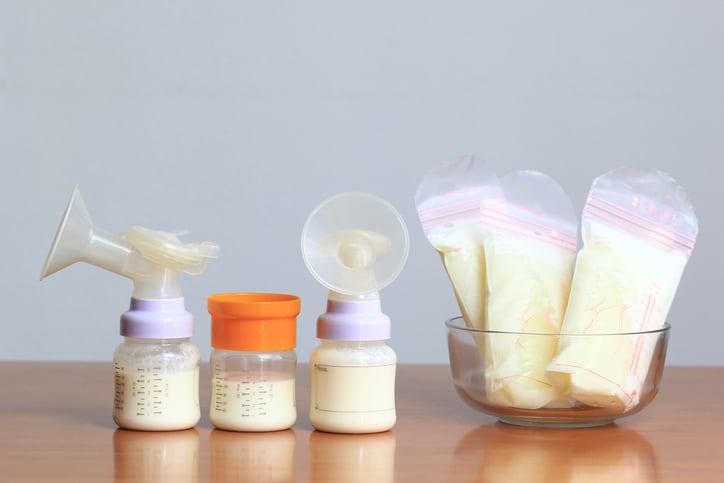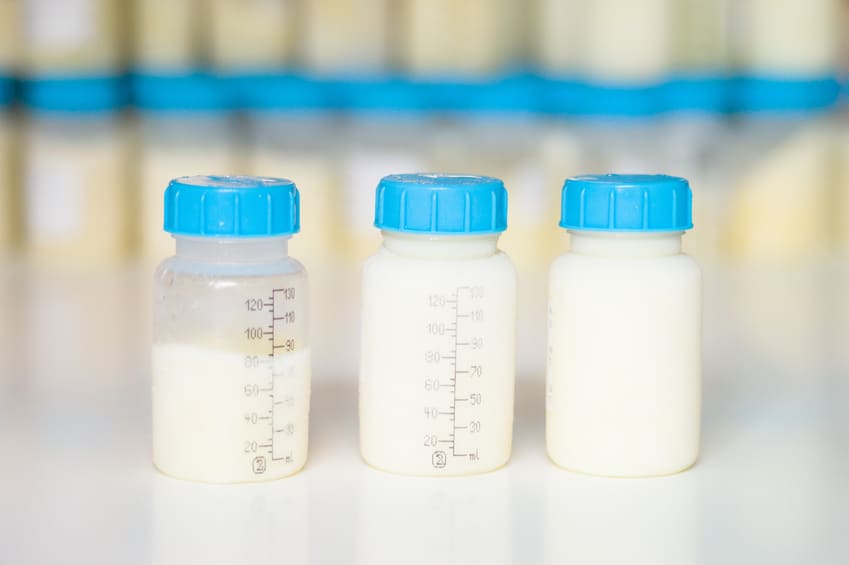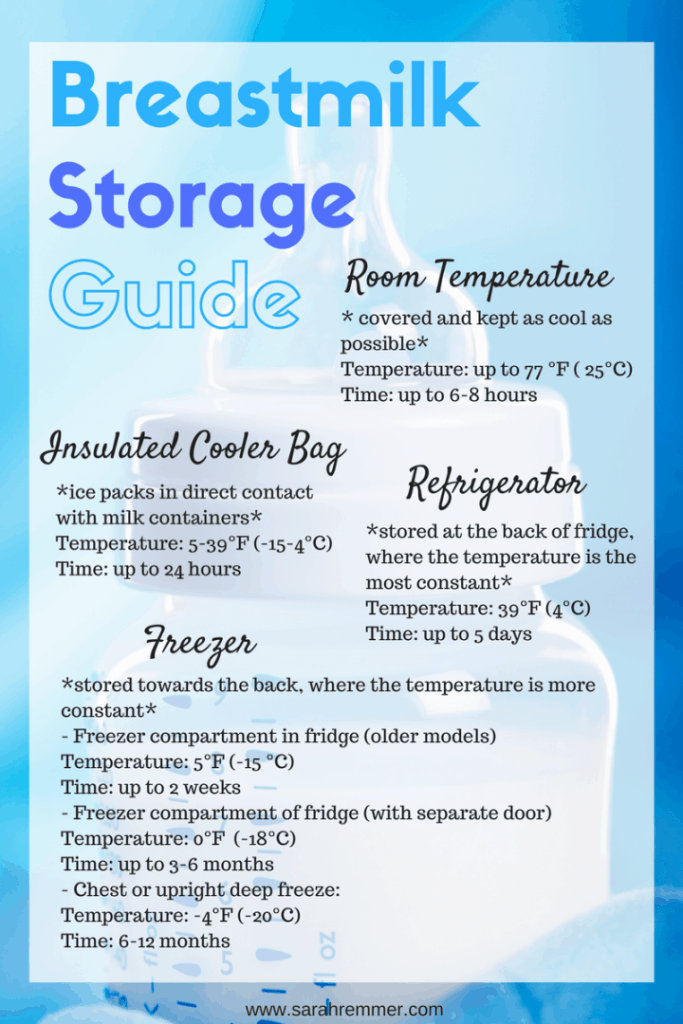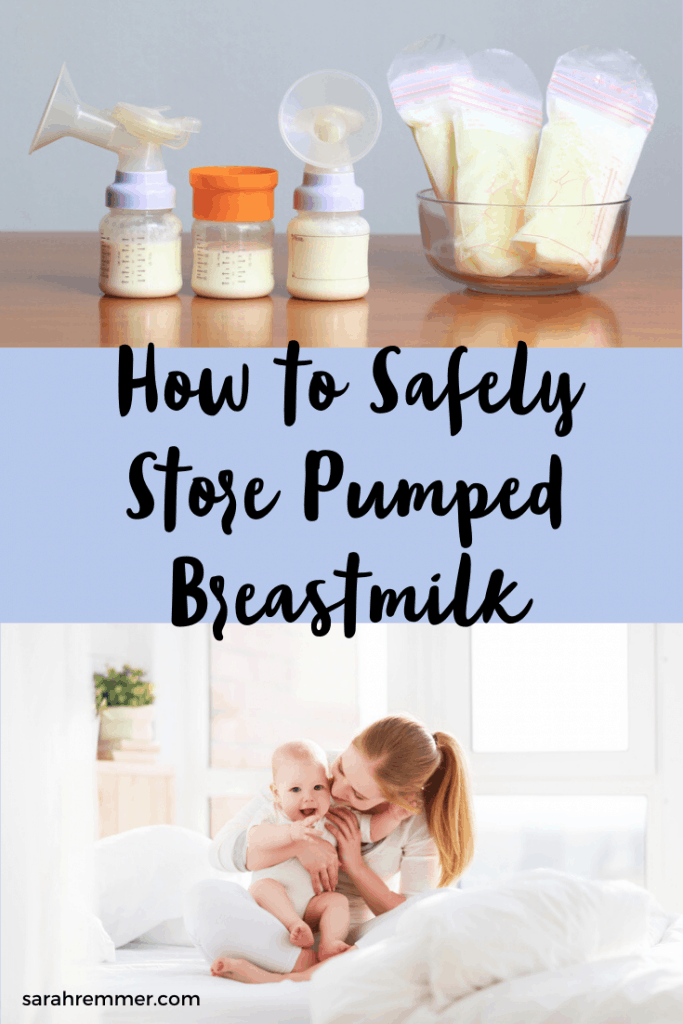I remember when I returned to work after having my third baby, one of my biggest sources of anxiety was how I was going to pump, transfer and store breastmilk at (and to and from) work. With a little bit of creativity, I was able to figure out a system that worked for me, and learning how to safely pump and store breastmilk at work was a key part of this.

Whether you’re a nursing Mom returning to work like I was, seeking a little bit of freedom to go out without baby in tow, or just want the option of feeding your baby a bottle instead of nursing, you might be wondering how to safely store your breastmilk, so that you maximize its nutrition and minimize waste.
After all, it is liquid GOLD!
If you’re like me and depend on your stored breastmilk to nourish your baby, read on to learn how to handle and store your breastmilk safely, according to the most up-to-date guidelines:

Preparing to express/pump and collecting breastmilk:
- Always wash your hands prior to expressing or handling breastmilk
- When expressing/pumping milk, make sure to collect it in clean or sanitized bottles with tight screw caps, nursing bottles, or freezer-safe milk storage bags. Avoid using formula bottle bags or regular storage bags, as they tend to leak easily and don’t always seal properly.
- Always label your bottles/bags with the date that it was expressed (so that you can use oldest milk first) and add your child’s name if you are giving the milk to a caregiver
- Avoid adding freshly expressed milk to previously frozen milk (it’s best not to mix), and discard milk from a bottle that was fed but not finished (don’t put back in the fridge to use later).
- Clean your pump supplies thoroughly after each use
Thawing Breastmilk:
- Thaw frozen breastmilk by transferring it to the refrigerator, or by running the bottle or bag under warm water (or placing it in a bowl of warm water).
- Do not use the microwave to thaw or heat breastmilk. Microwave ovens don’t heat every (this could lead to scalding the baby), and they can also damage the breastmilk and its nutrients.
- Do not re-freeze breastmilk one it’s thawed.

Storing breastmilk:
Room temperature (counter/table):
Container should be kept covered and as cool as possible
- Temperature: up to 77 °F or 25°C
- Time: up to 6-8 hours
Insulated cooler bag:
Make sure that ice packs are in direct contact with milk the entire time and minimize opening the bag
- Temperature: 5-39°F or -15 to 4°C
- Time: up to 24 hours
Refrigerator:
Store at the back of the main compartment in fridge, where the temperature is the most constant.
- Temperature: 39°F or 4°C
- Time: up to 5 days
Freezer:
Store towards the back of the freezer where the temperature is more constant. Note that milk stored for longer periods of time (within these ranges) will be safe, however some of the fat within the milk may degrade, resulting in a lower quality.
- Freezer compartment in fridge (older models)
- Temperature: 5°F or -15°C
- Time: up to 2 weeks
- Freezer compartment of fridge (with separate door)
- Temperature: 0°F or -18°C
- Time: up to 3-6 months
- Chest or upright deep freeze:
- Temperature: -4°F or -20°C
- Time: 6-12 months

Original post published on Super Healthy Kids (written by Sarah Remmer)
Information comes from the CDC (Centre for Disease Control) Guidelines for handling and storing breastmilk
If you enjoyed this post, you may also like these:
- 8 Tips For A Smooth Transition Back to Work for Breastfeeding Moms
- Starting Solids Basics: What Parents Need to Know



![[AD] It’s Day 6 of my 15-Minute Supper Series and today we’re putting a delicious twist on a classic BLT to make it nourishing and meal-worthy 🤤
Make sure to comment “Spud” and I’ll send you my top dietitian tips for feeding your family on busy weeknights along with a huge list of meal ideas!
This pasta salad takes no time at all to throw together and has everything you need for a nourishing meal. I always make extra bacon for things like this, but if you don’t have any cooked bacon I find cooking it in the airfryer or stovetop the quickest 🥓
I find that this salad lasts 2-3 days in the fridge without getting too soggy. You can also add in fresh lettuce to crisp it up or add the dressing when you eat it.
I ordered all of my groceries from @spuddelivers, which always saves me time and effort and gives me peace of mind knowing that I’m using high-quality, local and sustainable ingredients. I love that they come straight to my door the day after ordering 🙌🏻
Let’s make it!
Ingredients:
* 10 slices bacon cooked and diced
* 12 ounces pasta cooked and cooled
* 1 cup homemade Ranch dressing
* 1 ½ cup baby tomatoes diced
* ½ avocado diced
* feta
* ⅓ cup red onion diced
* 1 cup romaine lettuce
* fresh parsley for garnish optional
Homemade ranch dressing:
* ¾ cup mayonnaise
* ½ cup sour cream or Greek yogurt
* ½ teaspoon dried chives
* ½ teaspoon dried parsley
* ½ teaspoon dried dill weed
* ¼ teaspoon garlic powder
* ¼ teaspoon onion powder
* Salt and pepper to taste
Make it:
1. Blend all Ranch dressing ingredients together in a small blender (or whisk by hand) and set aside.
2. In a large bowl assemble the pasta, tomatoes, avocado, cheese, red onion, lettuce and bacon.
3. Pour the dressing over and toss to combine.
4. Garnish with parsley and serve.
You are going to LOVE this meal-worthy salad, I promise!
Comment SPUD to receive my top dietitian-approved tips for feeding your family during the week, a long list of ideas, and a curated shopping list with all of the ingredients for this recipe + all of the other ideas that I share in this resource!
#sponsored #spuddelivers #15minutemeals #whatsfordinner #easymealideas #dietitianapproved](https://www.sarahremmer.com/wp-content/uploads/sb-instagram-feed-images/438745920_798281295514125_2547899647147267180_nfull.jpg)





Comments
Breastfeeding Tips for New Moms says
Great post. Thanks for sharing this informative article.